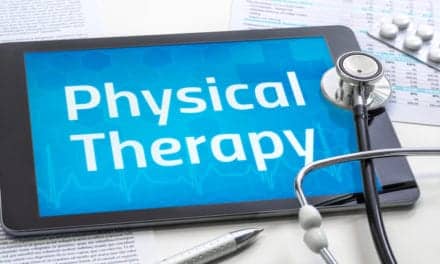photo caption: A physical therapist assists a patient in an exercise to treat the patient’s ankle injury, aiming to build strength and increase mobility.
by Thomas R. Denninger, PT, DPT, OCS, FAAOMPT
Separate recent systematic reviews by Hanney1 and Rutten2 have demonstrated that care that is consistent with guidelines results in improved outcomes and decreased cost—the definition of high value. However, another systematic review by Zadro found that only about 63% of patients receive care from physical therapists that is consistent with recommendations.3 This finding in itself should not be overly surprising given that only 14% of research findings have entered mainstream clinical practice in 17 years.4,5 If the benefits of consistent care are so high, why aren’t more therapists following it? Backed by evidence and analysis, this article aims to provide insight into this chasm.
Origins of Guidelines
The idea of clinical practice guidelines (CPGs) entered the medical literature in the early 1990s. Subsequently, there has been an enormous proliferation of published guidelines for various diagnoses, practice settings, and specialists. Physical therapy has a more recent history of guidelines, as the first broad-scale initiative to define expected care was undertaken by the Academy of Orthopedic Physical Therapy beginning in the mid-2000s. Subsequently, 14 guidelines and three revisions have been published in the Journal of Orthopedic and Sports Physical Therapy. Other academies have followed suit in producing documents that represent a synthesis of the available literature to guide care.
In 1999, 10 years after the emergence of physician-centered guidelines, Cabana published the hallmark paper, “Why Don’t Physicians Follow Clinical Practice Guidelines?” a framework for improvement stemming from the aforementioned gap between care guideline and practice.6 The six themes identified that served as barriers to implementation were awareness, familiarity, agreement, self-efficacy, outcome expectancy, ability to overcome the inertia of previous practice, and absence of external barriers to perform recommendations. Cote in 2009 and Da Silva in 2015 published similar work investigating physical therapists’ practice with themes that included understanding of the CPGs, compatibility to current practice (poor generalizability of research), perceived irrelevance or interest, level of agreement, and lack of time and skills.7,8 All of these factors serve as barriers to implementation.
The Orthopedic Academy and its partners have eliminated the barrier of access as all CPGs are available on the JOSPT and Ortho Academy website as open access. There has been clear, consistent messaging regarding the project and the CPGs’ availability over the course of years in publications, podcasts, and sessions in conferences. Influencers who are highly visible in publications, social media, DPT education, and speaking engagements have engaged with the CPGs and promoted their use. Despite this, penetration of documents into the clinical zeitgeist remains suboptimal.

Research and Practice Need Each Other
If we zero in on the Cabana, Da Silva, and Cote articles, the consistent hurdle distills to a lack of perceived importance or clinical benefit.6,7,8 The mantra of “Sure, that works in research, but my patients are different,” is commonly heard in clinics. Conversely, many clinicians will dismiss traditional treatment due to a lack of research support. A quote credited to F. Scott Fitzgerald is, “The test of a first-rate intelligence is the ability to hold two opposed ideas in mind at the same time and still retain the ability to function.” Complimentary to Fitzgerald’s thinking, Steven Rose once told Tony Delitto, “Our practice needs more research, and our research needs more practice.”9 One is not wrong to suggest that there are gaps in research and CPGs for specific clinical scenarios or that evidence should guide our practice; however, one is wrong to suggest that research does not apply to their patients or that clinical practice can be easily navigated simply by following published research and guidelines.
We find ourselves needing to disavow extremes and take to the middle passage, where we can accept that there are limitations to research and guidelines but that following the evidence seems to result in improved outcomes and value. This is balanced against the philosophy of patient beliefs, contextual factors, and the relationship between one single patient and a single provider (therapeutic alliance) potentially mattering more than anything else. The marriage of the two is the idea that best care is matching of the right treatment, at the right time, for the right patient.
Pain Management and Patient Beliefs
The promise of evidence-informed care would be that clinicians would be enabled to narrow the menu of potentially therapeutic routes they should take for a given diagnosis. For instance, by looking at randomized controlled trials, systematic reviews, and meta-analysis, clinicians would know broadly what modalities are likely to be successful or not. For example, in the recently published Clinical Practice Guidelines by the Orthopedic Academy for patients with Patellofemoral Pain, based upon the published literature there is moderate or strong evidence that clinicians should not use knee orthoses, dry needling, manual therapy in isolation, or biophysical agents (ultrasound, crythotherapy, phonphoresis, electrical stimulation, therapeutic laser, etc).10 Treatments with strong to moderate evidence for use include exercise, patellar taping, and prefabricated foot orthoses.10 These recommendations are based upon the systematic review of the available evidence.
However, for the patient who presents with high irritability and reports increased pain with low-level exercise and a belief based on experience of the pain-relieving effects of a modality, the correct decision for that individual patient at that time may be to use a treatment that has evidence against its effectiveness. Should the mainstay of this hypothetical patient’s care be exercise? Yes, but to disregard that there may be a specific window of time, for a specific patient, for a specific non-evidentiary treatment is likely short-sighted. Again, very few or no patients with anterior knee pain would have success exclusively with modality-driven care. In fact, only a few may need it at all based on level of their severity, irritability, and patient expectations. Should we really be rallying against short-term adjunctive care as a bridge to more active interventions?
Recipe for Accelerating Change
To move clinical practice guidelines to a desired saturation point in care, a more in-depth journey between researchers and clinicians must occur. To date, physical therapy has been hugely successful in the discovery phase of knowledge creation and has made inroads to translation through the creation and distribution of CPGs. However, there is a lack of translational science in our practice. Our entry-level and post-professional education systems are riddled with antiquated ideas, and contemporary practice is stagnant. This is akin to rolling a football out to a group of people with no knowledge of the sport and expecting an intricate offensive system to spontaneously materialize. Change research has demonstrated that by passively letting research fold into practice, there is a 14% absorption rate over 17 years. However, with an implementation team utilizing change management strategies, that rate can be 80% in 3 years.11,12
A serious attempt at “making it happen” through an implementation team would include specific goals, a robust exploration of the situational factors, and a frank conversation about the impetus to change. Next, multimodal distribution of the prerequisite knowledge should be highly visible with multiple points of access to allow active targeted direction and also passive consumption.13 Specific to clinical practice guidelines, the evidentiary summary sheets are more accessible; however, most of these documents are 30 to 50 pages long, which is overwhelming and unrealistic for many clinicians. Single-page documents that give tangible direction in care are needed. Additionally, if change requires an increase in psychomotor or operational performance, access to training is needed. Physical therapists have demonstrated to fall in the converger and assimilator domains of Kolb’s experimental learning theory (ELT), meaning that adoption and implementation require contemplation and conceptualization, not simply jumping into the fray without preparation.14
Lastly, simply posting the rules of a game and making sure the required equipment and skills are available does not, once again, result in manifesting a complex performance. There needs to be a cadence of practice with gradual expectations. Additionally, motivation plays a huge role in this, as no doubt some folks are not interested or have disagreement with particulars. Having earnest conversations about how change will benefit individuals, make their life easier, and benefit their patients is a must.13 This requires attention to compatibility with belief structures, the ability to trial in small doses, and observe the benefit others have actualized.
Clear Steps
As the evidence in this article shows, clinical practice guidelines are necessary but insufficient. If we want to elevate the practice through our patient outcomes by increasing the uptake and adherence to CPGs, there are clear-cut steps to take. Among those steps is an acknowledgement of how patient expectations interact with the evidence. Our willingness to delve into discomfort and follow a process will decide whether we can convince everyone to do it. RM
Thomas R. Denninger, PT, DPT, OCS, FAAOMPT, is the Senior Director of Market Research and Development at ATI Physical Therapy. He attended Sacred Heart University, completing his DPT and Orthopedic residency. Denninger’s research agenda and duties revolve around increasing best practices clinical behavior in outpatient musculoskeletal physical therapy. For more information, contact [email protected].
References
- Hanney WJ, Masaracchio M, Liu X, Kolber MJ. The Influence of physical therapy guideline adherence on healthcare utilization and costs among patients with low back pain: a systematic review of the literature. PLoS One. 2016 Jun 10;11(6):e0156799.
- Rutten GM, Degen S, Hendriks EJ, Braspenning JC, Harting J, Oostendorp RA. Adherence to clinical practice guidelines for low back pain in physical therapy: do patients benefit? Phys Ther. 2010 Aug;90(8):1111-22.
- Zadro J, O’Keeffe M, Maher C. Do physical therapists follow evidence-based guidelines when managing musculoskeletal conditions? Systematic review. BMJ Open. 2019 Oct 7;9(10):e032329.
- Reis SE, McDonald MC, Byers SJ. Crossing the research valleys of death: the University of Pittsburgh approach. Clin Transl Sci. 2008 May;1(1):9-10.
- Morris ZS, Wooding S, Grant J. The answer is 17 years, what is the question: understanding time lags in translational research. J R Soc Med. 2011 Dec;104(12):510-20.
- Cabana MD, Rand CS, Powe NR, et al. Why don’t physicians follow clinical practice guidelines? A framework for improvement. JAMA. 1999 Oct 20;282(15):1458-65.
- Côté AM, Durand MJ, Tousignant M, Poitras S. Physiotherapists and use of low back pain guidelines: a qualitative study of the barriers and facilitators. J Occup Rehabil. 2009 Mar;19(1):94-105.
- da Silva TM, Costa Lda C, Garcia AN, Costa LO. What do physical therapists think about evidence-based practice? A systematic review. Man Ther. 2015 Jun;20(3):388-401.
- Delitto A. We are what we do. Phys Ther. 2008 Oct;88(10):1219-27.
- Willy RW, Hoglund LT, Barton CJ, et al. Patellofemoral pain. J Orthop Sports Phys Ther. 2019 Sep;49(9):CPG1-CPG95.
- Green LA, Seifert CM. Translation of research into practice: why we can’t “just do it”. J Am Board Fam Pract. 2005 Nov-Dec;18(6):541-5.
- Saldana L, Chamberlain P, Wang W, Hendricks Brown C. Predicting program start-up using the stages of implementation measure. Adm Policy Ment Health. 2012 Nov;39(6):419-25.
- Rutten GM, Harting J, Bartholomew LK, et al. Development of a theory- and evidence-based intervention to enhance implementation of physical therapy guidelines for the management of low back pain. Arch Public Health. 2014 Jan 15;72(1):1.
- Stander J, Grimmer K, Brink Y. Learning styles of physiotherapists: a systematic scoping review. BMC Med Educ. 2019 Jan 3;19(1):2. doi: 10.1186/s12909-018-1434-5.





